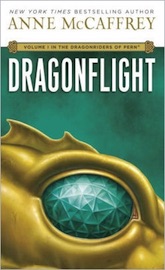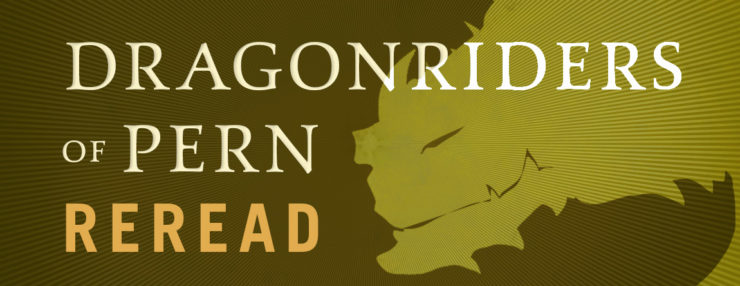In later interviews with press and fans, Anne McCaffrey would bristle at any attempt to classify her Dragonriders of Pern series as fantasy. Her dragons, she pointed out, were genetically engineered animals ridden by descendants of space explorers, not magical elves. The language of Pern was not a creation of the author, but descended in a fairly straight line with only a few expected deviations from English and, after McCaffrey moved to Ireland, a few Irish cadences. The plots focused on the development and rediscovery of technology. Most importantly, the presence of dragons, fire lizards, and just a touch of telepathy aside, no one in her Pern books could do magic. They focused on technical solutions to their problems—the use of nitric acid; telegraph machines; metal tools and machines; bioengineered invertebrates; and, when possible, spaceships.
Magical, Pern was not.
And this was all perfectly true—for most of the short stories, novellas and novels about Pern and its dragons and fire lizards.
Which makes it feel rather odd to start off a Pern reread by noting that the first work in the series—the one that started everything off—is, well. Fantasy. Pure pulp fantasy, at that. And not just because of the dragons.
Weyr Search, or Dragonflight, part one, if you prefer, opens as a young woman, Lessa, wakes up with a sense of foreboding and danger, and a young man, F’lar, begins his Search. These two events might just be related.
More specifically, F’lar, the rider of bronze dragon Mnementh, is hunting for the next Weyrwoman for the Weyr.
It’s a lot of new verbiage to take in at once.
But hey, DRAGONS.
Buy the Book


Dragonflight
F’lar has decided to head to the High Reaches, an unpleasant place in the north, under the theory that adversity and uncertainty makes for strong-minded people who are exactly what the Weyr needs just now—not those indolent yet lovely women in the south.
We’ve barely started this, and F’lar and I already need to have a long talk. Moving on.
Geography is only one of the High Reaches’ many problems. It’s also under the control of Fax, who has conquered five Holds, married into a sixth, and inherited the seventh. He’s also borderline rude and has a tendency to ignore various Laws and Traditions, including the one about Sending Food to the Weyr to Keep the Dragons and Dragonriders Fed. So, it’s easy to see why F’lar might get a bit annoyed.
Pause for a verbiage break:
Holds: In this section, castles, more or less; in later books, a large stone/cave dwelling that provides very necessary shelter from alien life forms.
Dragons: Awesomely large creatures who fly and can somehow communicate with their riders.
Weyr: Where the dragons and dragonmen live.
Weyrwoman: Rider of the queen dragon. In this section, there can apparently Be Only One.
F: A letter that McCaffrey seems to like to use in names: of the six people in this section with major dialogue, THREE have names starting with F – F’lar, F’nor and Fax.
Ancient Laws: Things Fax likes to ignore. Many of them involve keeping everything as ungreen and rocky as possible.
F’nor: F’lar’s brother. He will become important later; here, he’s mostly there as someone else for F’lar to talk to and Fax to be rude to.
Watchwhers: Weird beasts that howl a lot, are mostly blind, and are used as watch animals. Also, they seem to have a strange fascination with human genetics.
Back to the story. All of this misery fails to help F’lar find the right strong-minded woman trained up in adversity, so off he heads to Ruatha Hold, one of Fax’s conquests, along with Fax, some of Fax’s women, and various other dragonmen. Ruatha, it seemed, was Quite the Place in the past, and frequently provided women for the Weyr. Now, however, they find Ruatha a complete disaster area, thanks to the manipulations of Lessa of Ruatha.
The last surviving daughter of the last Lord of Ruatha, capable of changing the shape of her face and body with a mere thought, Lessa is determined that Fax will not profit from slaughtering her family, and has been using her not inconsiderable other psychic skills to nearly destroy Ruatha. Fax is appalled; F’lar convinced that he has found the new Weyrwoman. Lessa uses her psychic powers to manipulate F’lar into killing Fax in a duel, just as Fax’s wife Gemma expires during early childbirth.
Impressed by all this—
(yes, I went there)
—F’lar convinces Lessa that she can do much more than manipulate people into preparing inedible food, destroying their own lives, and murdering each other, and takes her off to the Weyr. Ruatha is left under the control of Gemma’s newborn, Jaxom, who, SPOILER, will be a central character in upcoming books, and former dragonrider Lytol, another major character in upcoming books, given rather short shrift here by the narrative and F’lar.
At the Weyr, to the relief of everyone involved, Lessa has a bath, before F’lar scoops her up and flies her to the nearby volcanic sounds where dragon eggs are hatching. Boys get injured and mauled by dragons. A little golden dragon hatches, immediately kills one woman, severely injures another, and heads for Lessa, who has the common sense to try to stop the little beast before it can injure more people. Lessa bonds with the dragon, finds out the dragon’s name is Ramoth, and decides to get the little dragon some food.
End of part one.
And, wow.
Shapechanging humans! (Ok, only one shapechanging human—Lessa. But still.) Watchwhers who will only respond to the Blood! Swaggering swordsmen! Harems! Extreme misogyny! Doom-laden prophecies! Crowing cocks! Dogs! Or, more specifically, canines! Even more specifically, canines working in the kitchens by rotating the spits, ensuring that the meat is evenly cooked! A reference to a male green dragon, referred to quite clearly as him! F’lar concerned about adhering to traditions!
Not to mention all the murder: F’lar killing Fax in a duel! Fax almost casually massacring various holders! Lessa less casually murdering or arranging the deaths of various minor officials desperately trying to restore Ruatha to functionality. And those baby dragons killing various hopeful dragonriders!
(And yes, keep that in mind in later books—Lessa has used her mental powers to kill. It’s not clear how many people other than F’lar know this, but presumably at least a few other people and dragonriders would be able to make an educated guess. Which in turn helps explain Lessa’s later isolation—but we’ll get to that.)
All so radically different from what would follow that, if not for the familiar names of Lessa, F’lar, Lytol and Jaxom, readers could be forgiven for thinking that this section is from an entirely different series.
Some of the differences can be excused away as minor elements that McCaffrey simply hadn’t considered yet. For instance, how to render the telepathic dragon speech, making it clear that her dragons were communicating, but not actually speaking—communications that could not be heard by most humans. Here, that speech was represented as reported dialogue without quote marks, a somewhat clumsy way of letting readers know that the dragons aren’t actually speaking out loud, but can communicate.
(It also helped leap over the “uh, how can they form human speech without human jaws, tongue and teeth” problem, something that musically trained McCaffrey put significant thought into in all of her descriptions of alien life.)
In the two later novellas that formed the rest of this novel, she came up with an ingenious solution later borrowed by other writers: rendering those dragon communications with italic markings. This worked so well that it became her standard method of transcribing the speech of dragons to their riders, but it was evidently something that had not occurred to her at this early stage.
Other minor parts were simply quietly updated without explanation. That green dragon, for instance, was later changed to a brown (and male but still dead) dragon called Larth in the indexes to the later books. The term “birthing woman” was replaced with “Healer.” Humans took over turning the spits, displacing the dogs. With no need to help cook meat, the dogs disappeared for several books as well, replaced in their roles as pets and guard animals by fire lizards and watchwhers. The chickens became wherries. Everyone, it turned out, was eager to follow the standard Baby Dragon Safety features ignored—or just not developed—here.
But the largest shifts, I think, occurred for other reasons. Namely, in this initial work, McCaffrey was primarily interested in a dialogue with the classic fantasy works of the pulps. In the 1950s, that meant stories that featured magic, dragons, duels, conquerors and harems. But this interest soon waned, replaced by an interest in science fiction—stories that featured few if any of those things. The occasional conqueror remained, of course, as did the occasional harem. But if McCaffrey wanted to use Pern to explore concerns of technology—and she did—she had to drop most of those fantastical trappings.
She wanted dragons. So those stayed. But the rest vanished. After one brief, final appearance later in this novel, the swaggering swordsmen disappeared, replaced by swaggering belt knife wearers. The harems vanished, replaced by largely monogamous, heterosexual pairings in the holds and crafthalls and comparatively open sexual arrangements in the Weyrs. And just three decades later in Pern’s timeline, the easy acceptance of murder, massacre and death in Fax’s timeline would be superseded by Pernwide horror at a single attempted murder—along with the sense that murder just isn’t the sort of thing that happens on Pern.
With at least two killers—Lessa and F’lar—witnessing every word of this.
So smoothly done, it’s hard to realize just how unusual it would be for any planet—even a planet with dragons—to have that sort of cultural shift.
And Lessa’s magical abilities to transform the look of her face and skin, and force people to do and speak things through her mental command? Well, that didn’t vanish completely—Lessa continues to use her abilities to influence others—but her abilities were greatly toned down in later books, and no one else on Pern learned to shapeshift. I must admit I’m kinda sorry about this: I would have loved to see the later adventures of Lessa, Shapeshifter of Pern.
Which is to say, I kinda wonder what might have happened had Pern—the books as much as the planet—kept the feel of this opening, and remained a fantasy series.
This must have been at least slightly tempting. Weyr Search was an immediate success. It was nominated for the 1967 Nebula and won the 1968 Hugo for Best Novella, triumphs that allowed McCaffrey to write two more novellas set in Pern, and eventually bundle them into a novel, Dragonflight. But for whatever reason, McCaffrey avoided this temptation, managing to transform her fantasy world of dragons and swordsmen into something quite, quite different.
But first, she had to take a long, hard, look at the educational systems of Pern—and deal with those standing armies.
Coming up in part two.
Mari Ness currently lives rather close to a certain large replica of Hogwarts, which allows her to sample butterbeer on occasion. Her short fiction has appeared in Clarkesworld, Lightspeed, Fireside, Apex, Daily Science Fiction, Nightmare, Shimmer and assorted other publications—including Tor.com. Her poetry novella, Through Immortal Shadows Singing, was released in 2017 by Papaveria Press. You can follow her on Twitter @mari_ness.










